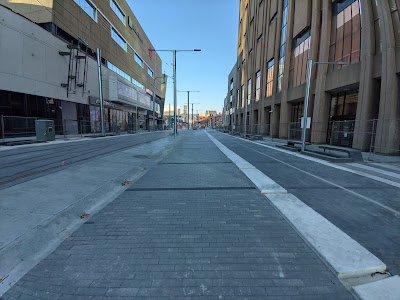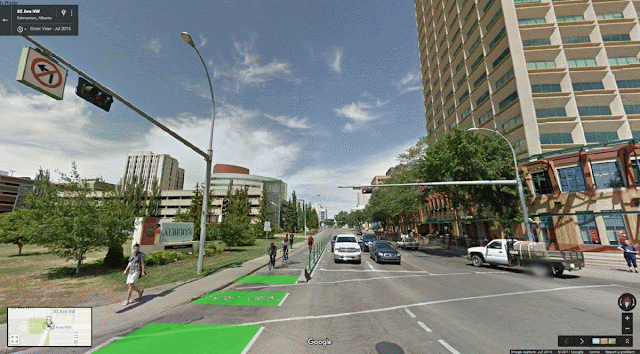This is Part 2 of a look at an imaginary bikegrid near the University of Alberta.
In
Part 1 we talked about improving the existing bikelanes on 116st, and providing a 2-way cycletrack on 87ave by removing the leftturn lanes.
Those additions bring us to here:
In this map the darker green lines show older, reasonably high-quality cycling infrastructure. The lighter green lines show what is being installed this year: the 83ave cycletrack, and the 76ave/106st improvements. The orange lines show some quick-wins that we looked at for 110st and 111st. And the purple lines are what we looked at in Part 1: 116st and 87ave.
That's a good start, and it provides much more connectivity than what we have today, but why stop there?
Warning: this is all complete make-believe, but it doesn't have to be.
114 Street and 87 Avenue
Last time we talked about finding space for a 2-way cycletrack on 87ave by removing the leftturn lane. Here we've done the same thing for 114st.
114 Street around 84 Avenue
Because of the LRT line on the westside of 114st, running the cycletrack on the westside is both good and bad. (more good than bad, though)
It's a bit bad, because it means that anyone biking to the University Hospital would need to cross 114st, and that's annoying.
It's really good though, because it means that there aren't many places where vehicles would ever turn across the cycletrack - 83ave is the only spot. Not having to worry about right or left turners is a huge benefit.
114 Street & University Avenue
And here's where everyone will claim this is impossible.
When the South LRT was built a lovely multi-use trail was included just behind it, running from University Ave to Belgravia. There's one problem, though - you can't get to it. It's not that it's fenced off, but as someone walking you are not legally allowed to cross on the westside of 114st.
If you are walking to the 114st multi-use trail you are required to travel around 3 sides of this intersection in a large "U". And if you are on a bike the only connection is one-block detour down a sidestreet from 115st which then sneaks through the bowels of University's boiler plant. Maybe that expensive multi-use trail was only put there for show?
When the SLRT opened there was traffic chaos, which was caused in part by signalling issues at this intersection. But it's been almost a decade now, and the world hasn't ended. And does anyone remember what traffic was like on 114st before SLRT? It was the exact same thing, except that there were dozens more buses on the road.
So whether or not a cycletrack goes through here, it's long past time for the city to allow pedestrians to legally cross on the westside of the intersection. And if we're doing that anyway, then we might as well add a cycletrack to connect to the orphaned multi-use trail, and from there on to 76ave.
Right now this intersection is so wide that is has a median which takes up two entire lanes of traffic. By reducing that it would be possible to retain the right-turn lane - although right-turns would have to be coordinated with the green for the cycletrack.
112 Street & 83 Avenue
On the other side of the University Hospital is 112st.
It is two-lanes of traffic each way, with a leftturn lane that comes and goes. To install a cycletrack on 112st some spots would look like this - two lanes each way with a leftturn lane, changed to two lanes each way and a cycletrack. In other spots it would go from two lanes each way, to one lane each way, and a leftturn lane, and a cycletrack.
The benefit of adding a cycletrack to 112st is that it could connect to the new cycletrack that is being installed this year on 83ave. That connection isn't really possible from 114st, because the Hospital is in the way. (this would also require extending the 83ave cycletrack to 112st, when the current plan is to stop at 111st. But we're thinking big here.)
112 Street & Whyte/University Avenues
The other benefit of adding a cycletrack on 112st is that it would fix this intersection.
This is another spot that I rode through for a long time, before finally deciding that it was just too much of a risk and giving up. Riding southbound is fine, but riding northbound forces a lone cyclist to stare-down 2 lanes of left-turning traffic. It really is a nightmare, and I'm sure that it gave me nightmares on more the one occasion.
Personally, I don't believe that there is a worse spot anywhere on Edmonton's official bikemap (although I'm open to suggestions). Putting a 2-way cycletrack on the westside of the intersection would greatly simplify things, although now rightturns would have to be coordinated with the cycletrack. But from there people on bikes can connect to the relatively quiet streets of McKernan.
The Updated Map
Here is what we get when we add 114st and 112st in purple.
The fixes and additions that we've looked at - to 110st, 111st, 112st, 114st, 116st, and 87ave - are a total of about 4.5km of new cycletrack. But because of all of the new connections that it provides - to Saskatchewan Drive, 76ave, 83ave, 106st - the overall southside network would be in excess of 15km.
From here there's room for even more improvement - University Ave from 112st to 114st, or 83ave from 112st to 114st, or further north on 110st or 112st, or further west on 87ave, or etc. But compared to what we have now, this would be a great start.
To do this we'd need to remove some lanes, and that sounds scary. But it's important to remember how much the traffic in this area has changed recently. A decade ago 112st and 114st were
packed with busses. It wasn't 2-lanes each way - it was 1-lane, and then a wall of ETS blue. Today those busses have mostly disappeared, and that space has been reclaimed by single-occupant vehicles. But it doesn't have to be that way.







































